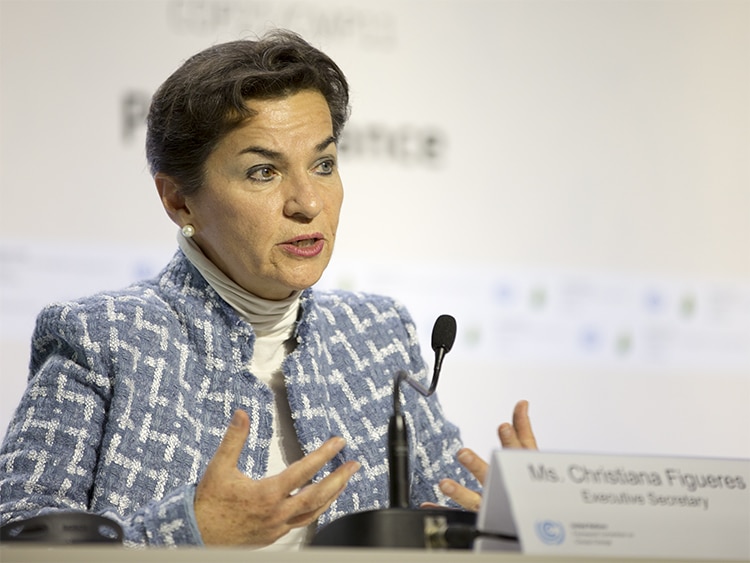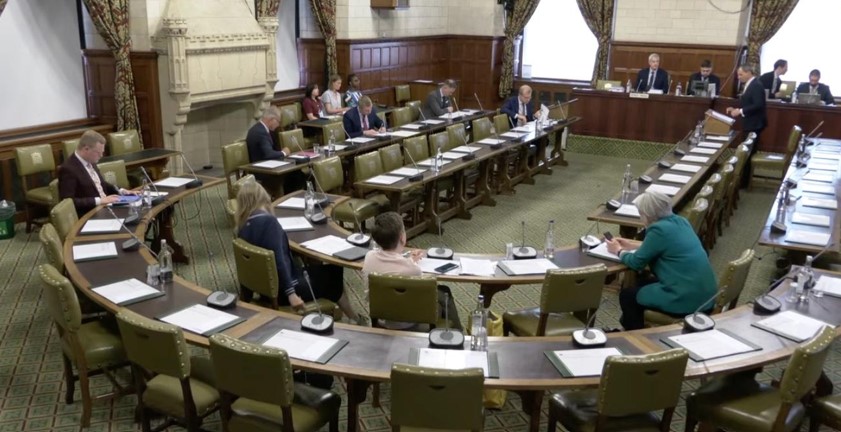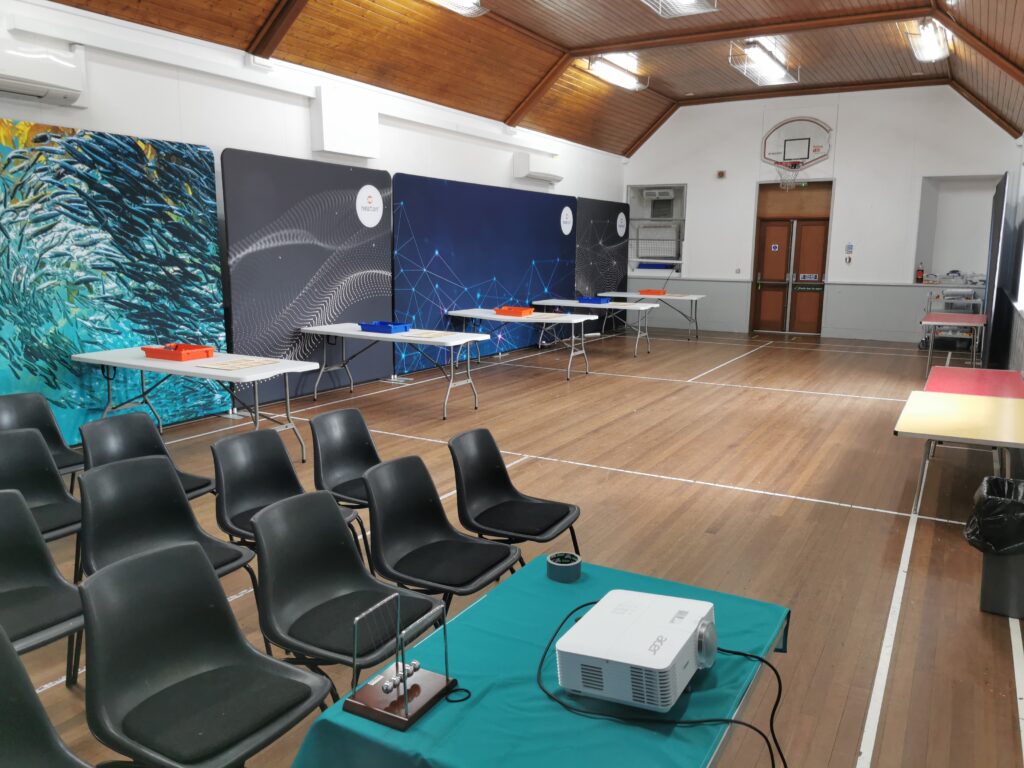Christiana Figueres, the UN climate chief who led the world to the Paris climate deal, spoke to a full house Monday evening at the Grantham Institute for Climate Change’s annual lecture at Imperial College London.
As nations are set to gather in New York next week to sign the deal, Figueres told the audience that she expects the Paris Agreement to come into effect in 2018 – two years earlier than expected.
But she was quick to point out that the success of COP21 was the easy part. Now, it’s time to achieve its goals and the clock is running out fast she said.
Her talk also emphasised the importance of tackling climate change in order to eradicate poverty and of the important role women have to play in getting us there.
Here we break down the 10 key takeaways from her speech.
1.Paris Deal Will Take Effect in 2018
“You heard it here first, I think we will have the Paris agreement in effect by 2018,” Figueres told the audience during the question period following the lecture.
As she explained, the original text of the Paris deal said that it would come into force in 2020.
“At some point… the decision was made to remove that sentence,” she described. “The reason why that sentence was removed was because of a collective sense of actually, this could come into effect before 2020. It wasn’t that we made a mistake, there was a collective decision.”
Nations will be arriving in New York City next week to sign the Paris Agreement on April 22. The signing will be open for a full year, however there is much anticipation to see how many countries show up to sign on the first day.
The current record for the most signatures on the opening day of an international treaty is the Law of the Sea, where 119 nations signed. Currently, 130 countries have confirmed they will come to New York to sign the Paris Agreement, and half of those will be represented by their heads of state or government – “which is just amazing,” Figueres exclaimed.
The Paris deal will come into effect only once at least 55 countries that represent at least 55 percent of our greenhouse gas emissions have ratified the deal.
2.COP21 Was the Easy Part
“We have a stark choice in front of us,” Figueres said. “Paris points in one direction, but that is only a blueprint.”
“As difficult as the Paris agreement was… it took the entire world… to contribute to it, and yet, that was the easy part. Now we come to the difficult part because now we have to be intentional about everything that we do.”
“We need to be prepared to think about the choices we are making,” she warned. “The choice is for us, nobody can exempt you from making that choice.”
3.We’re 10 Years Too Late
“I feel frankly that I’ve swallowed an alarm clock because of all this,” Figueres told the audience. “So I invite all of you to swallow an alarm clock because it really does make a difference what we’re doing today.”
“It’s fantastic we got a Paris Agreement, but the Paris Agreement is 10 years too late,” she said. “And it has really put an incredible amount of pressure on to innovation, onto energy evolution, because now we have to get to being able to get peaking [emissions] very soon and descent, and we should have had a little more time, but we have actually exhausted that time.”
Figueres broke down the time frame and urgency from a carbon budget perspective: “If you express it in emissions we get a very clear picture.”
As she described, we have already emitted 2,000 gigatons of CO2 into the atmosphere. “Unless we invent some huge vacuum cleaner that is going to zap that out from the atmosphere, that is going to stay there for hundreds of years.”
If we want to keep average global temperature increase to 2C, there are only 1,000 gigatons left to emit. “Not for this year, this decade or this century,” she emphasized, “we would only have 1,000 gigatons left for the rest of the time that human society decides to live on this planet.”
Now, if the world wants to keep warming to just 1.5C, there are only 600 gigatons left.
Putting it into perspective, each year the world emits 32 gigatons. So at our current business as usual rate, we would reach the 600 gigatons limit in less than 19 years, 1,000 gigatons in about 31 years.
Under the Paris deal, the world has agreed to reach net zero emissions by the second half of this century. In order to do, our emissions must peak, and then drop, very quickly.
“In my book, we would have to peak by 2020,” she said. “That is not where we are right now. Our business as usual would have us peaking at between 2025 and 2035. So you can see what I mean by the Paris Agreement being 10 years too late.”
4.Climate Change Has an Inbuilt Physical Urgency
Part of what makes the challenge of climate change unique is that is has an “inbuilt physical urgency” beyond its social, moral and economic urgency, described Figueres.
“That physical urgency has very little elasticity, in fact, we are two minutes to midnight on climate change.”
“A world that goes over 2 degrees would have human costs in addition to the economic costs beyond anything that we would feel is responsible for us as human beings,” she said. “Because the loss of land, of livelihood, the loss of homes, and the loss of life, would be unmeasurable.”
“We do have physical urgency in keeping the increase in temperature to well below 2 degrees or 1.5.”
5.A World Beyond 2C Is Systemically Uninsurable
The insurance sector is “the risk guru of the world” described Figueres, emphasizing that global climate change is “the highest risk we have ever faced”.
“They have decided that a world that goes above 2 degrees is uninsurable,” she said. “Not that they won’t be able to insure your home or your business, but what they’re saying is a world that goes above 2 degrees is systemically uninsurable. Can you image you would live in an economy that is systemically uninsurable?”
6.There’s Only One Way to Go for Economic Growth
“We cannot afford, as a society, to increase access [to energy] or to solve poverty – as some would argue – with high carbon. It is just absolutely anathema,” Figueres said.
Highlighting several of the areas focused on by the Sustainable Development Goals such as access to energy, economic growth, and industrial innovation, Figueres argued there is only one way we can move: towards a low carbon economy.
“Yes we have to improve access to energy around the world, but there’s only one direct that can occur, and that is toward low carbon energy… It’s the same [with economic growth.] Yes we need economic growth… but there’s only one way that the economic growth can go and that’s decoupling GHG7.The Quality of Investment Matters
As Figueres put it: “The quality of investment today equals the investment of energy tomorrow equals the quality of life forever.”
This brings home the “importance of today” she said.
“It is not correct to think we’re going to deal with climate change tomorrow, or by the year 2050. We have to deal with it today, we have to make an intentional choice to actually invest into R&D, into all kinds of technological innovation, into resilient infrastructure, low carbon infrastructure. Otherwise, we’re locking ourselves in.”
And with the cost of renewable energy, for example, continuing to drop, while efficiency improves, there’s no time like the present to start investing.
8.More Carbon Equals More Poverty
There is a causal relationship between climate change and poverty said Figueres. “More carbon equals more poverty. And it is in nobody’s interest to have more poverty.”
“Now let me be specific, more carbon in the atmostphere, not carbon in the soil, but more carbon in the atmosphere… equals more poverty. And it especially equals more poverty among the already poor and vulnerable populations.”
This is because climate change will impact food and water security, as well as increase health costs, all of which produce higher costs for national economies and “disproportionally affects those at the bottom of the pyramid”.
“If I were to summarize the Paris agreement into one sentence I would say the Paris agreement is all about how are we going to decouple GDP… from GHG?” she said. “Because GDP, economic growth, and greenhouse gas emissions have been increasing hand in hand for 150 years and that can no longer be the case.”
“We need to decouple those two curves. If we don’t do that, we are actually sealing ourselves into a world of more inequality.”
9.Zero Carbon Only Way to Make Poverty Eradication Possible
“Net zero emissions is actually the only way to make poverty eradication possible at all,” Figueres said.
While poverty is affected or magnified by other things beyond the carbon intensity of energy, “there is a very, very close relationship between zero carbon… and less poverty” she said, explaining that decarbonisation allows for the world to restore its lands, improve agricultural productivity, stabilise aquifer, and increase access to energy. Not just that, but it would help improve the resilience of our infrastructure and allow for energy independence.
“Going to that zero emissions [goal] is the only way we stand any chance of eradicating poverty, less poverty in the world, which is our common goal here, is actually the only way to ensure we can withstand the impacts of climate change.”
She added: “It’s a very simple conclusion. Yes more carbon equals more poverty. But also less carbon equals more growth, more jobs, more stability, more benefit for everyone.”
10.The Only Way to Move Forward Is To Walk With Both Feet
Figueres told the audience that there is “a very interesting phenomenon, that there is a preponderance of men in the energy sector and a growing preponderance of women in the climate change sector. What’s that that all about?”
“Maybe one could say, well maybe women are working on the solution part,” she laughed.
Describing this phenomenon in simplistic terms, Figueres said it’s in part because women tend to think more long-term, and are generally more inclusive and collaborative.
“Can you imagine any topic that needs more inclusion or collaboration than climate change?” she asked.
“Maybe what we need now is more participation,” she argued, “because we have for thousands of years, as a human race… frankly my dear friends, we have been hobbling along, hopping with 50 percent of the talent, 50 percent of the productivity, 50 percent of the potential of mankind.”
“We have two genders, in case you haven’t noticed, and we have two feet. So the only way to move forward is to use both our feet, ok?”
She continued: “It does us no good to keep 50 percent of the potential, 50 percent of the skills, somewhere in a closet. Bring that 50 percent out and let us contribute to the solution, because hopping with 50 percent hasn’t really gotten us very far.”
Photo: UN Climate Change via Flickr
Subscribe to our newsletter
Stay up to date with DeSmog news and alerts







